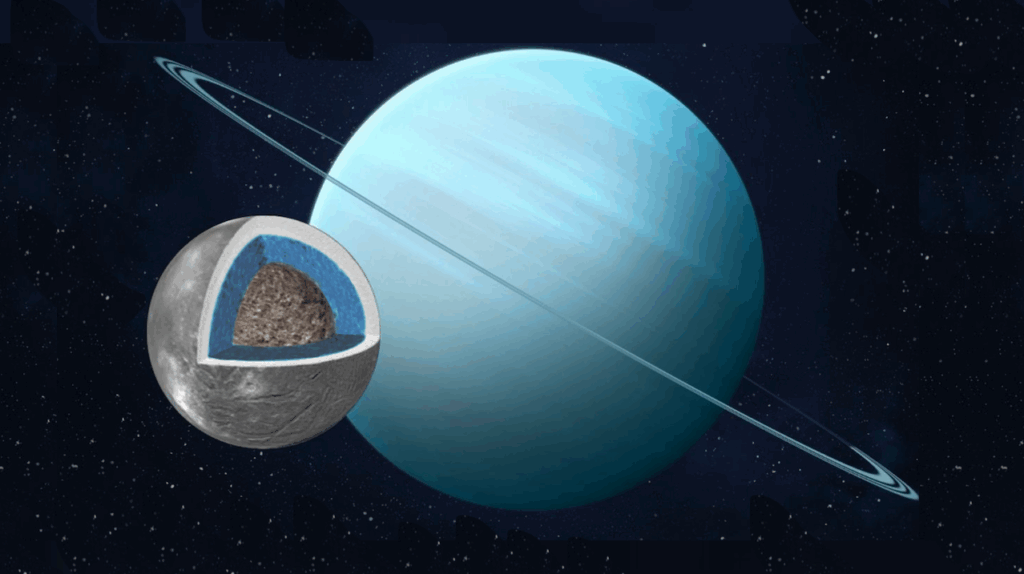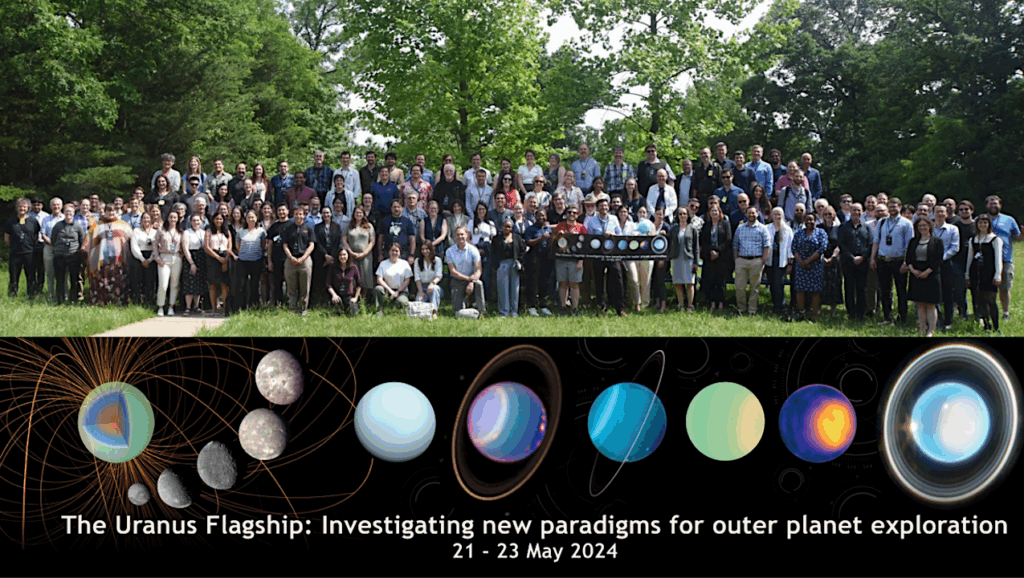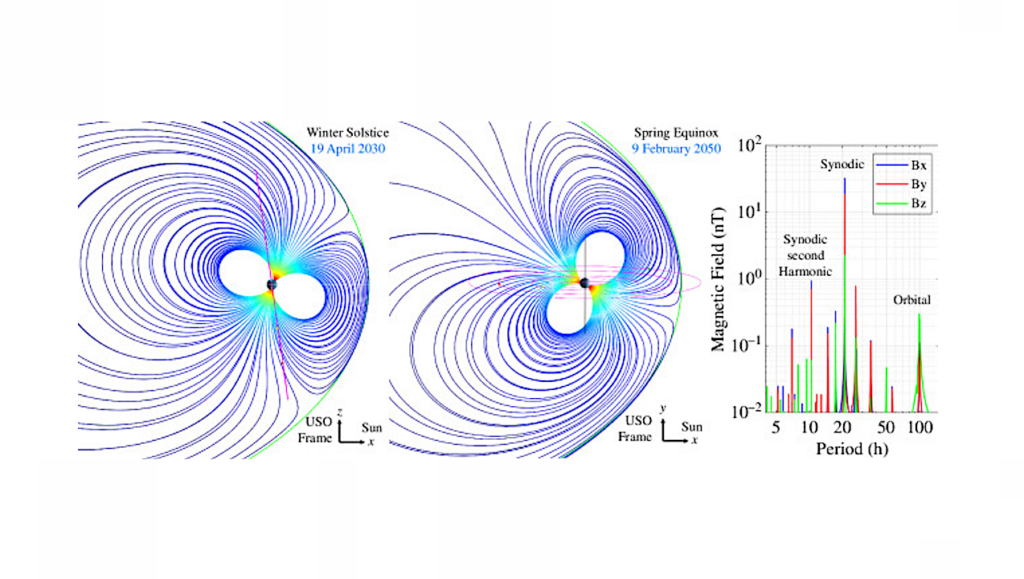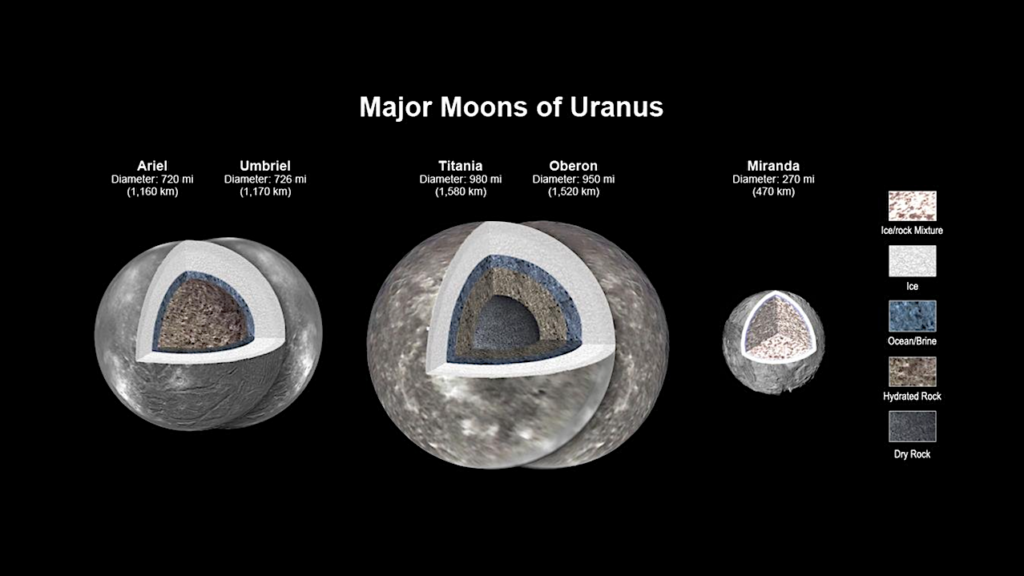Ocean Worlds: New Study Suggests Trench-Like Features on Uranus’ Moon Ariel May Be Windows to Its Interior
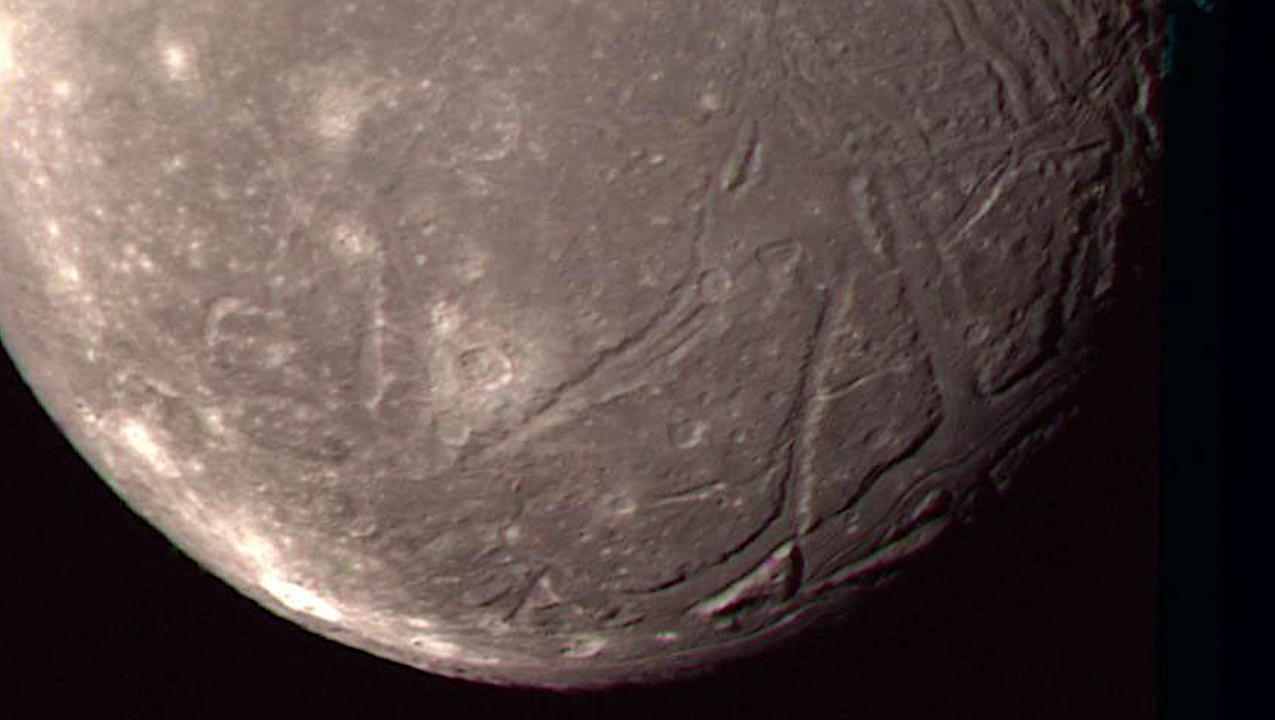
Last year, a study led by planetary scientist Richard Cartwright at the Johns Hopkins Applied Physics Laboratory (APL) in Laurel, Maryland, proposed that deposits of carbon dioxide ice and other carbon-bearing molecules on Uranus’ moon Ariel likely originated from chemical processes inside the moon — possibly even from a subsurface ocean.
Now, new research may shed light on how those materials reached (or are even still reaching) the surface. A study led by APL planetary geologist Chloe Beddingfield points to medial grooves — trenches that cut through Ariel’s massive canyons — as the likely conduits for this exchange. The findings, published Feb. 3 in the Planetary Science Journal, suggest these grooves are spreading centers, like those creating new oceanic crust in Earth’s seafloors by bringing up internal material that forms a new surface.
“If we’re right, these medial grooves are probably the best candidates for sourcing those carbon oxide deposits and uncovering more details about the moon’s interior,” Beddingfield said. “No other surface features show evidence of facilitating the movement of materials from inside Ariel, making this finding particularly exciting.”
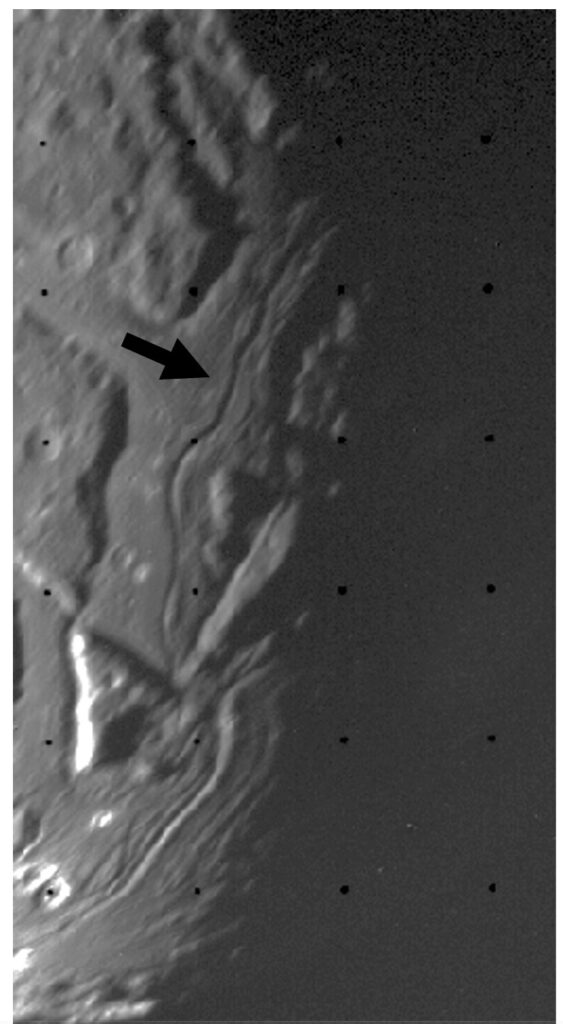
An image taken by Voyager 2 of Ariel’s surface displays a medial groove (marked by an arrow), which new research suggests is a spreading center where new surface material has been deposited. The image has been cropped and modified for emphasis. Credit: NASA/Jet Propulsion Laboratory
Among Ariel’s youngest known surface features, the grooves have long been suspected to be products of a complex interplay between tectonic and volcanic activities. Using images taken by NASA’s Voyager 2 spacecraft (the only mission to pass by Uranus and its moons), the research team considered that the grooves may have formed through fissures or volcanic conduits. But the new analysis leans strongly toward spreading centers. For instance, the canyon walls flanking the grooves fit together like puzzle pieces when their central floors are digitally removed. And the canyon floors display regularly spaced ridges in some locations — akin to the tracks of a construction excavator — consistent with a series of material depositions.
Spreading centers arise from convection cells beneath the crust, Beddingfield explained. Heat from Ariel’s interior causes material to ascend, splitting the surface and forcing it apart as the material is emplaced and gradually cools. Curiously, Ariel and several of Uranus’ other moons have experienced multiple periods of geological activity, likely driven by tidal forces. These forces, stemming from the moons’ period resonances — where their orbital periods align in precise ratios — caused their icy interiors to cycle between phases of heating, in some instances melting, and freezing.
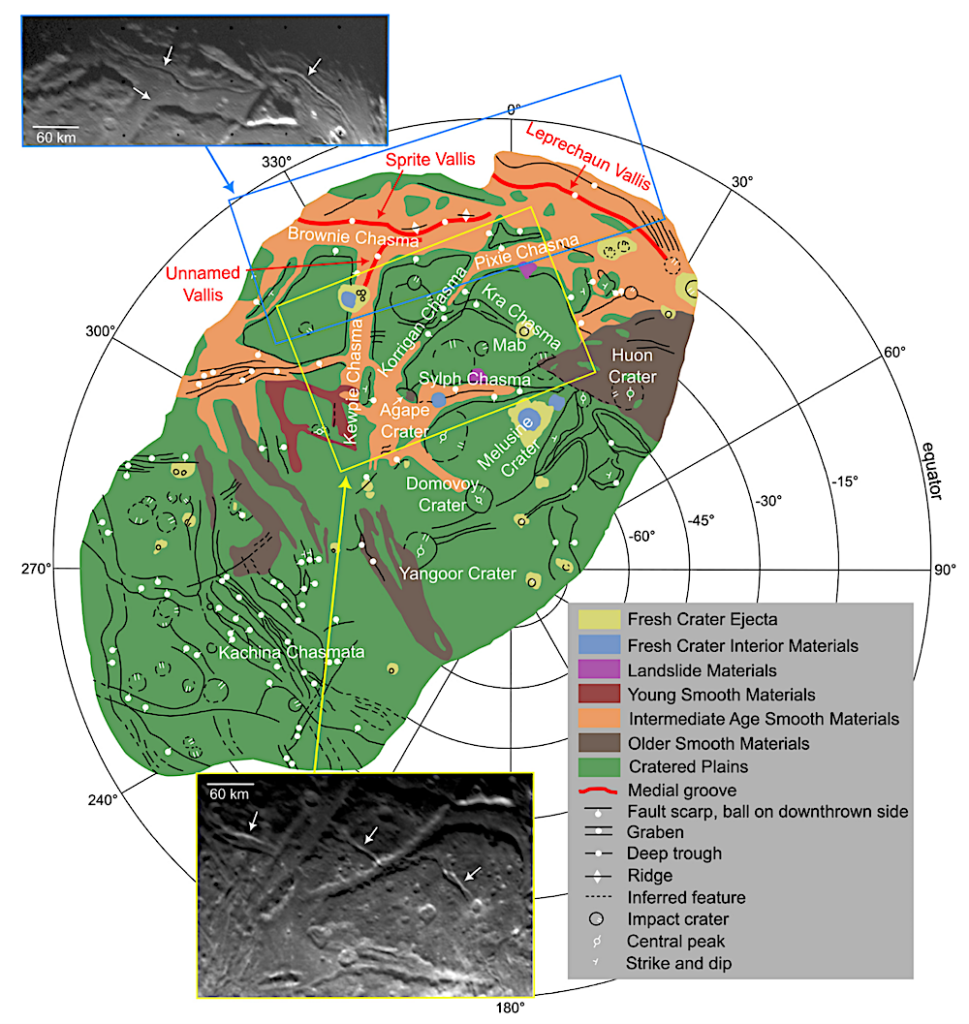
Geologic map and Voyager 2 ISS images of Ariel. The base figure is a digitized and modified version of the geologic map presented in S. Croft & L. Soderblom (1991). Locations of the three known medial grooves are shown in red. See S. Croft & L. Soderblom (1991) for detailed descriptions of mapped units and geologic features. The top blue-bordered Voyager 2 ISS image covers the three medial grooves identified on Ariel (arrows) and where they disappear beyond the terminator (c2684539, V. I. S. Team 1988, 995 m pixel−1). The bottom yellow-bordered ISS image covers three offset fracture systems including Kra Chasma (arrows; c2684535, V. I. S. Team 1988, 999 m pixel−1). While CO and CO2 exhibit stronger spectral features over Ariel’s trailing hemisphere, observations by JWST and ground-based facilities are disk integrated, and we cannot discern finer detail on the distribution of these constituents, even at the regional scale. Understanding the spatial relationship between geologic features like medial grooves and carbon oxides is not possible at this time and requires high spatial resolution spectral data collected during close flybys by a Uranus orbiter. — The Planetary Science Journal
“It’s a fascinating situation — how this cycle affects these moons, their evolution and their characteristics,” Beddingfield said.
Scientists think these resonances helped sustain oceans beneath Ariel and its smaller neighbor Miranda. For instance, a 2024 study co-authored by APL’s Tom Nordheim proposed that such resonances formed an ocean within Miranda’s interior, and that the ocean might still exist today. When it comes to Ariel’s possible ocean, Nordheim highlighted the importance of the medial grooves for understanding the likely short lifespan of carbon oxides. “These new results suggest a possible mechanism for emplacing fresh material and short-lived compounds, including carbon monoxide and perhaps ammonia-bearing species on the surface,” he said.
Ariel, too, may host a thin remnant ocean, although Beddingfield remains cautious about drawing direct links between that ocean and the medial grooves.
“The size of Ariel’s possible ocean and its depth beneath the surface can only be estimated, but it may be too isolated to interact with spreading centers,” she said. “There’s just a lot we don’t know. And while carbon oxide ices are present on Ariel’s surface, it’s still unclear whether they’re associated with the grooves because Voyager 2 didn’t have instruments that could map the distribution of ices.”
To find answers, Cartwright emphasized the need for further exploration and the importance of a dedicated Uranus mission. “We need an orbiter that can make close passes of Ariel, map its medial grooves in detail, and analyze their spectral signatures for components like carbon dioxide and carbon monoxide,” he said. “If carbon-bearing molecules are concentrated along these grooves, then it would strongly support the idea that they’re windows into Ariel’s interior.”
With Uranus climbing the ranks of exploration priorities, Ariel and its enigmatic medial grooves may soon come under closer scrutiny, offering an unprecedented look into the moon’s past and possibly even its present.

(a) Orthorectified Voyager 2 ISS image c2684539 (V. I. S. Team 1988, 995 m pixel−1) showing the locations of Ariel’s three identified medial grooves, Unnamed, Sprite, and Leprechaun Valles. The chasmata in this area are labeled in white. See Figure 1 for latitude and longitude information for these features. (b) A digital elevation model (DEM) showing the topography of the region covered in panel (a). White arrows show locations of the marginal valleys. See Sections 2.1 and A.1 in C. B. Beddingfield et al. (2022) for discussion on how this DEM was generated. The spatial resolution of the DEM is 995 m pixel−1. White dots are associated with reseau points in panels (a) and (b). Topographic profiles show the following: A–A’: axial troughs with raised rims making up the medial groove called Sprite Vallis. B–B’: the bowed-up chasma floor and bounding marginal valleys of Pixie Chasma. C–C’: subparallel ridges bounding the medial groove called Leprechaun Vallis. D–D’: a full profile across the chasma-medial groove system of Brownie Chasma and Sprite Vallis. — The Planetary Science Journal
To learn more about APL’s work on the Uranian moons and ice giants, visit the Ice Giant Research and Exploration page.
Ariel’s Medial Grooves: Spreading Centers on a Candidate Ocean World, The Planetary Science Journal (open access)
Astrobiology


